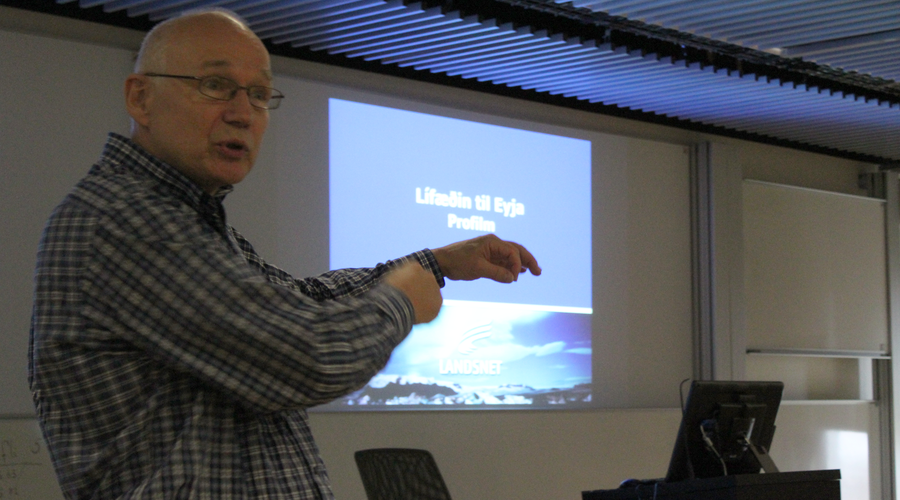Meet the Industry - 11 November 2016
Ingólfur Eyfells presents the VM3 interconnector project to ISE students.
 This Friday ISE hosted another Meet the Industry event for its students. Speaker today was the former Landsnet project manager Ingólfur Eyfells who would give students a detailed account of his project of the planning, designing and eventual installation of a 66kV submarine cable connection between Landeyjarsandur and Heimaey, the largest of the Westman Islands. The need for a new interconnection was created by the breakdown of the younger of two already existing connections between the mainland and the island group off the South Coast of Iceland. This project was a multinational effort, spearheaded by Landsnet, the Icelandic TSO, and their Norwegian sister, Statnett. Experts from Norway and Sweden were brought in to either help on the ground or provide expertise on how to swiftly and accurately develop a 13km interconnector.
This Friday ISE hosted another Meet the Industry event for its students. Speaker today was the former Landsnet project manager Ingólfur Eyfells who would give students a detailed account of his project of the planning, designing and eventual installation of a 66kV submarine cable connection between Landeyjarsandur and Heimaey, the largest of the Westman Islands. The need for a new interconnection was created by the breakdown of the younger of two already existing connections between the mainland and the island group off the South Coast of Iceland. This project was a multinational effort, spearheaded by Landsnet, the Icelandic TSO, and their Norwegian sister, Statnett. Experts from Norway and Sweden were brought in to either help on the ground or provide expertise on how to swiftly and accurately develop a 13km interconnector.
 What made this project so noteworthy according to Ingólfur, was on the one hand the tremendously detailed documentation of the entire process (linked below) and on the other hand had to be completed in presumably record time. Between the failure of VM2 in September 2012, and the completion and successful electrification of the new VM3 in October 2013, only little more than a year went by. During this time, all phases of the project, from design and planning to procurement and installation, had to be completed. By the end of it, a 13km long submerged 66kV cable with a total capacity of 60MVA had been successfully installed by Swedish automation technology giant ABB and their subcontractors. The cable delivers far more than just electricity to the Westman Islands, included within are state of the art fibre-optics communication technologies that secure telecommunication availability and access to the internet of things.
What made this project so noteworthy according to Ingólfur, was on the one hand the tremendously detailed documentation of the entire process (linked below) and on the other hand had to be completed in presumably record time. Between the failure of VM2 in September 2012, and the completion and successful electrification of the new VM3 in October 2013, only little more than a year went by. During this time, all phases of the project, from design and planning to procurement and installation, had to be completed. By the end of it, a 13km long submerged 66kV cable with a total capacity of 60MVA had been successfully installed by Swedish automation technology giant ABB and their subcontractors. The cable delivers far more than just electricity to the Westman Islands, included within are state of the art fibre-optics communication technologies that secure telecommunication availability and access to the internet of things.
In his talk Ingólfur highlighted the different steps of development from the project management perspective. He especially focused on the expected hurdles this project would have to face along the way. To name a few, the project management expected to run into difficulties with the permitting, designing of such a cable could prove difficult to the Icelandic companies due to limited experience in the field, the installation required tremendous accuracy along a very rough seabed while faced with some of the strongest currents in the North Atlantic and battling Icelandic weather. Ingólfur highlighted also how being aware of these possible difficulties beforehand, appropriate counter measures could be taken to some extent. Previous ocean bed surveying for a water pipeline on the other hand proved incredibly useful for the planning of the new connector, as has the involvement of Statnett added valuable expertise on the actual technical procedures.
 After having faced difficulties at the landing of the cable on the Icelandic mainland, the connecting of the cable to Heimaey proved far easier. The collective expertise of the Norwegian and Swedish contractors as well as a lucky spell with the weather in the end allowed the acutal submerging of the cable in a total of four days.
After having faced difficulties at the landing of the cable on the Icelandic mainland, the connecting of the cable to Heimaey proved far easier. The collective expertise of the Norwegian and Swedish contractors as well as a lucky spell with the weather in the end allowed the acutal submerging of the cable in a total of four days.
In the end the project was completed succesfully and now provides more energy security to the people and businessnes of Heimaey.
The key to successful project management, according to Ingólfur's concluding remarks, truly is being adequately prepared for what obstacles you may encounter in your project. Accounting for delays, accidents or bad weather in all stages of the project therefore is vital to its eventual success. Important takeaways for students highlighted by Ingólfur were centered around how to make such large multinational efforts run as smoothly as possible. A clearly visible hierarchical structure of responsibility and command for example, has been found make a tremendous difference.
We would like to thank Ingólfur Eyfells once more for taking the time to talk to our students today and provide them with the valuable insights into successful planning of large engineering / infrastructure projects such as this one.
Below you can find a 30-minute documentary commissioned by Landsnet on this project.
